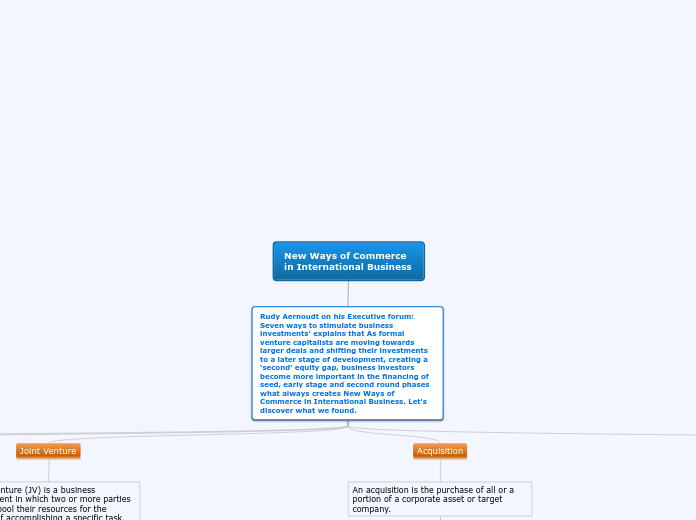New Ways of Commerce in International Business
Rudy Aernoudt on his Executive forum: Seven ways to stimulate business investments' explains that As formal venture capitalists are moving towards larger deals and shifting their investments to a later stage of development, creating a ‘second’ equity gap, business investors become more important in the financing of seed, early stage and second round phases what always creates New Ways of Commerce in International Business. Let's discover what we found.
License Sale
A business arrangement in which one company gives another company permission to manufacture its product for a specified payment. Licensing lets you instantly tap the existing production, distribution and marketing systems that other companies may have spent decades building.
How it works?
For example, about 90 percent of the $160 million a year in sales at Calvin Klein Inc. comes from licensing the designer's name to makers of underwear, jeans and perfume.
Example
Subway
Subway is a restaurant or franchiser that sells the rights to use and distribute its products to franchisees the individual restaurant owners. All franchise agreements are slightly different, but most of them have a two-part payment plan.
Franchise Opportunities
A continuing relationship in which a franchisor provides a licensed privilege to the franchisee to do business and offers assistance in organizing, training, merchandising, marketing and managing in return for a monetary consideration. Franchising is a form of business by which the owner (franchisor) of a product, service or method obtains distribution through affiliated dealers (franchisees).
In order to analyze a franchise will be acquired through the following:
Best Franchises to Buy
1. McDonald's
2.7-ElevenDunkin'
3.The UPS Store
4.RE/MAX
5.Sonic Drive-In
6.Great Clips
7.Taco Bell
8.Hardee's Restaurant
9.Sport Clips
*Interviews with the franchisor
*Interviews with existing franchisees
*Examination of the franchise's Uniform Franchise Offering Circular (UFOC)
*Examination of the franchise agreement
*Examination of the franchise's audited financial statements
*An earnings-claim statement or sample unit income (profit-and-loss) statement
*Trade-area surveys
*List of current franchisees
*Newspaper or magazine articles about the franchise
*A list of the franchisor's current assets and liabilities
Joint Venture
A Joint Venture (JV) is a business arrangement in which two or more parties agree to pool their resources for the purpose of accomplishing a specific task. This task can be a new project or any other business activity. In a joint venture (JV), each of the participants is responsible for profits, losses, and costs associated with it. However, the venture is its own entity, separate from the participants' other business interests.
Key Takeaways:
*A JV is a Business arrangement in which two or more parties agree to pool their resources for the purpose of accomplishing a specific task.
*They are a partnership in the colloquial sense of the word but can take on any legal structure.
*A common use of JVs is to partner up with a local business to enter a foreign market.
Example
Volvo Uber Joint Venture
Recently, Volvo and Uber have also announced that they would form a joint venture to produce self-driving cars. The ratio would be 50%-50%. As per the agreement, they are doing a $300 million investment for this JV. Uber will purchase Volvos and then install its own driverless control system for the specific needs of its ride-hailing service.
Acquisition
An acquisition is the purchase of all or a portion of a corporate asset or target company.
Examples
1. Microsoft and Skype 2. TransCanada and Columbia Pipeline Group 3. DELL and EMC 4. Google acquired android for $50 million in August 2005
Commonly mistaken
Commonly mistaken with a merger which occurs when the purchaser and the target both cease to exist and instead form a new, combined company.
Direct Investment
Foreign direct investment is when an individual or business owns 10 percent or more of a foreign company. If an investor owns less than 10 percent, the International Monetary Fund defines it as part of his or her stock portfolio.
TYPES AND EXAMPLES
Horizontal
A business expands its domestic operations to a foreign country. In this case, the business conducts the same activities but in a foreign country.
EXAMPLE
McDonald’s opening restaurants in Japan would be considered horizontal FDI.
Vertical
A business expands into a foreign country by moving to a different level of the supply chain. In other words, a firm conducts different activities abroad but these activities are still related to the main business.
EXAMPLE
McDonald’s could purchase a large-scale farm in Canada to produce meat for their restaurants.
Conglomerate
A business acquires an unrelated business in a foreign country. This is uncommon as it requires overcoming two barriers to entry: entering a foreign country and entering a new industry or market.
EXAMPLE
if Virgin Group, which is based in the United Kingdom, acquired a clothing line in France.
Platform
A business expands into a foreign country but the output from the foreign operations is exported to a third country. This is also referred to as export-platform FDI. Platform FDI commonly happens in low-cost locations inside free-trade areas.
EXAMPLE
if Ford purchased manufacturing plants in Ireland with the primary purpose of exporting cars to other countries in the EU.
LAURA FIALLO LEONARDO GONZALEZ
Literature: https://www.entrepreneur.com/encyclopedia/licensing https://heinonline.org/HOL/LandingPage?handle=hein.journals/usflr36&div=8&id=&page=https://www.entrepreneur.com/encyclopedia/franchising https://www.investopedia.com/terms/a/acquisition.asp#real-world-example-of-acquisitions
https://www.investopedia.com/terms/f/franchise.asp
https://www.franchisedirect.com/top100globalfranchises/rankings
https://www.wallstreetmojo.com/joint-venture-examples/
https://legaldictionary.net/joint-venture/
https://www.investopedia.com/terms/f/fdi.asp
https://www.wallstreetmojo.com/mergers-and-acquisitions/
https://burniegroup.com/mergers-and-acquisitions/
Subtema
Subtema
Subtema
